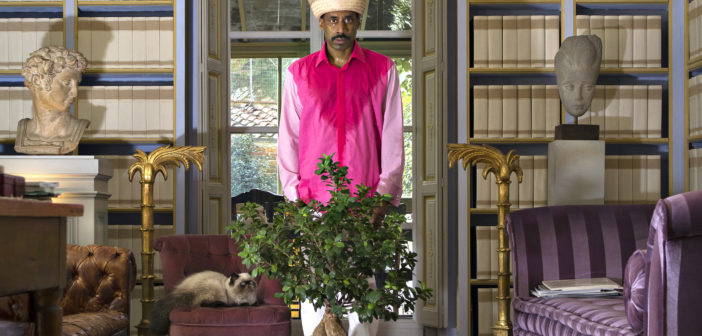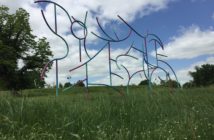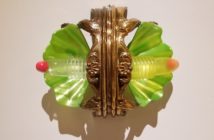Walking into Nari Ward’s retrospective Sun Splashed at the ICA Boston, you are greeted with calypso music piping out of a bright yellow bodega awning that reads HAPPY SMILERS in kitschy font. Hanging bottles of colorful Tropical Fantasy fruit soda ceremoniously adorn the entryway. Passing underneath the awning, the mood changes to contemplative as you enter a space lined with stacked couches, tables, fans, and other detritus tightly bound in crisscrossing, soiled firehoses. Actual fire escape stairs, surreally transplanted from a tenement building, hang from the ceiling in the center of the room. A lone aloe vera plant sits on the fire escape landing, hovering above a pristine, enclosed bed of salt mixed with sand. Against the back wall, giant dancehall speakers sit elevated on an AstroTurf “altar” playing the sound of rain hitting a tin roof.
The installation, originally made by Ward in 1996, is full of personal associations. Rain hitting a tin roof is a memory from Ward’s childhood in Jamaica, a place he left when he was twelve for the United States. “Happy Smilers” was the name of Ward’s uncle’s band whose music entertained tourists in the 1970s. Ward’s studio is an old firehouse in Harlem, and the storefront with a dual identity is inspired by his landlord’s illegal gambling site that fronted as a candy store.¹ The installation could be diced up and decoded along these lines, or you can just walk in and get lost in ambient sound of rain bouncing off a rooftop.

Nari Ward, Mango Tourist, 2011. Foam, battery canisters, Sprague Electric Company resistors and capacitors, and mango seeds; 3 figures, each 120 x 72 x 72 inches (304.8 × 182.9 × 182.9 cm). In collaboration with MASS MoCA, North Adams, Massachusetts Courtesy the artist and Lehmann Maupin, New York and Hong Kong. Image courtesy the artist and Lehmann Maupin, New York and Hong Kong© 2017 Nari Ward
Ward’s retrospective, spanning more than two decades of his work, leaves space open to mine political, cultural, and historical references after getting sucked in by evocative, often tactile, sculptures that use found objects toward surprising ends. Skillfully curated into thematic sections -- The Street, The Sky, and The Sun -- the exhibition does not unfold chronologically and lets Ward’s work from the 1990s talk directly with recent projects that often seamlessly cohere. This fits an artist who has a tendency to collapse his immediate experience of a place with his own past, responding to what he finds with personal associations or memories. Cast-off industrial waste (foam and electrical capacitors) found at MASS MoCA in North Adams are reshaped into totemic snowmen dubbed Mango Tourists (2011). Old bottles from Maine are strung together and suspended, alluding to the tradition of making bottle trees to ward off evil spirits brought by slaves from Africa to the Americas (Vertical Hold, 1996). Ward also taps the material and symbolic potential of urban discards collected in his home base of Harlem to make open-ended work where the past, the present, and the future become a dense, indistinguishable web.
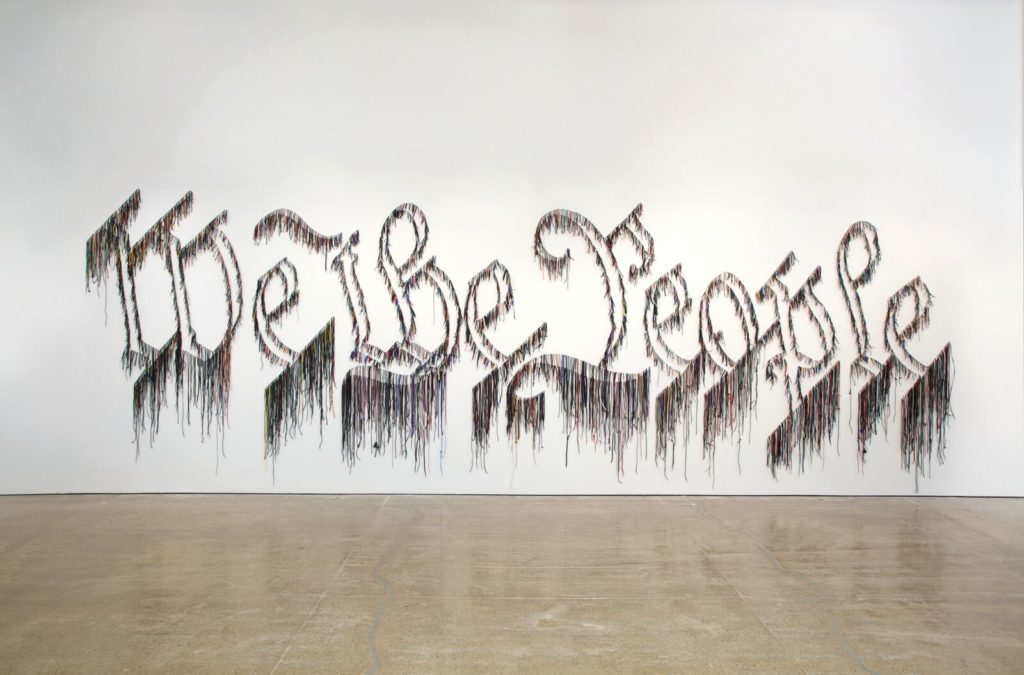
Nari Ward, We the People, 2011. Shoelaces, 96 x 324 inches (243.8 × 594.4 cm). In collaboration with the Fabric Workshop and Museum, Philadelphia. Courtesy the artist and Lehmann Maupin, New York and Hong Kong. Photo by Will Brown, image courtesy the artist, Lehmann Maupin, New York and Hong Kong, and the Fabric Workshop and Museum, Philadelphia© 2017 Nari Ward
The first gallery, The Street, presents some of the most explicitly political and legible work in the show, often incorporating text from the Constitution and iconic American imagery to tackle issues of rights and citizenship. In We the People (2011), the Constitution’s opening phrase is emblazoned across one gallery wall by hundreds of dangling multicolored shoelaces. Ward first created this piece during a residency at the Fabric Workshop and Museum in Philadelphia, the city where the foundational document was drafted and signed. Nearby, a funerary tanning bed constructed out of oil drums features glowing glass imprinted with the American flag that, if used, would burn the stars and stripes into your skin. The coffin-like tanning bed, titled Glory, was made in 2004 around the time of the invasion of Iraq. Its accompanying lighthearted soundtrack of phrases used to teach birds to speak, like “I’m a bad bird,” bring to mind the patriotic indoctrination of schoolchildren parroting back the pledge of allegiance.
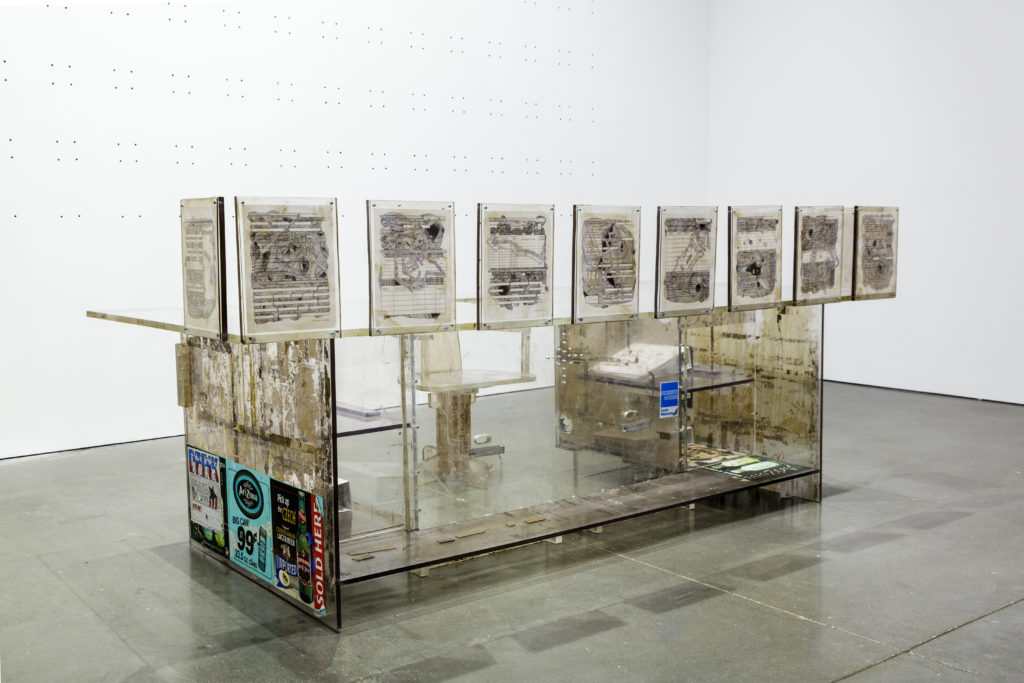
Nari Ward, Naturalization Drawing Table, 2004. Plexiglas, crenelation table, and INS naturalization application, two parts: table 45 x 51 x 99 inches; chair 34 x 22 x 21 inches. Courtesy the artist; Galleria Continua, San Gimignano, Beijing, Les Moulins, and Havana; and Lehmann Maupin, New York and Hong Kong. Installation view, Nari Ward: Sun Splashed, Institute of Contemporary Art Boston, 2017 Photo by John Kennard. © Nari Ward
In a side gallery, Naturalization Drawing Table (2004) repurposes the depressingly institutional Plexiglas windows that separate people at convenience stores, banks, police stations, or social service agencies into a functional desk. Hanging on the wall behind it, paperwork and passport photos show museum visitors who have taken part in the work’s invitation to go through a mini-bureaucratic process. When operational, participants can fill out a contract and take a photo in exchange for a print by Ward inspired by the doodles he made out of boredom on his own citizenship application. The piece is part of a larger question that preoccupies Ward: how are abstract systems of power made real, felt, and experienced?
This interest in concrete, everyday experience paradoxically fuels Ward to create work that finds transcendence through the derelict and discarded. The grouping of work brought together for The Sky section shows Ward at his most dynamic as he conjures the celestial in the ground beneath his feet. This happens quite literally in Oriented Right (2015), a recent work made at a residency at the Savannah College of Art and Design. Ward treated his shoes with chemicals and danced across a copper sheet, leaving an abstract patina of scuff marks. Radiating lines and a constellation-like pattern of holes punched in the sheet’s surface refer to the breathing holes that escaping slaves drilled into the floor of a hiding place along the Underground Railroad in the First African Baptist Church in Savannah, Georgia.² Placed opposite, Iron Heavens (1995), a work from twenty years earlier, also addresses the history of slavery. Ingeniously using the white speckled surface of broiling pans, Ward creates a monumental wall relief of the night sky. Charred baseball bats with patches of sterilized cotton lean against the pans like kindling for a funeral pyre. Slavery is conflated with “America’s favorite pastime,” and the brutal and elegiac work is one of the most powerful in the show.

Nari Ward Savior, 1996 Shopping cart, plastic garbage bags, cloth,bottles, metal fence, earth, wheel, mirror, chair, and clocks 128 x 36 x 23 inches (325.1 × 91.4 × 81.3 cm)Collection of Jennifer McSweeney Courtesy the artist and Lehmann Maupin, New York and Hong Kong. Photo by EG Schempf. Courtesy Nerman Museum of Contemporary Art© 2017 Nari Ward
The sculptures Savior (1996) and Crusader (2005) are kindred spirits despite being made nearly a decade apart. They look like ramshackle, mobile monuments with shopping cart bases that support dense weavings of trash bags, cloth, and plastic bags that bind various objects. In the towering Savior, a precariously perched chair sits high atop a leaning ladder and pays homage to the Shaker ideal that every chair is designed with the hope that an angel would come down from heaven to sit on it.³ Crusader takes the shape of an angelic wing-shaped cage, inside of which sits a trophy made from stacked winged figurines. A corresponding video documents two separate performances: in one, Ward pushes Savior down the street in a suit and hat, and in the other he stands inside of Crusader’s enclosure, using the trophy totem like a steering wheel as he walks. Adopting the persona of an itinerant street peddler or homeless man, most likely completely invisible or noticed and purposefully ignored, the exhibition catalogue describes the act as messianic. Crusader was doused in oil and lined with gas cans, referring to the conflict in Iraq that was contemporaneous with this performance. In his ritualistic performance, Ward stops at a gas station to methodically spin a black, planetary ball attached to the front of the cart. It feels mournful as he looks at a charred world turning on an inevitable path toward violence and trauma.
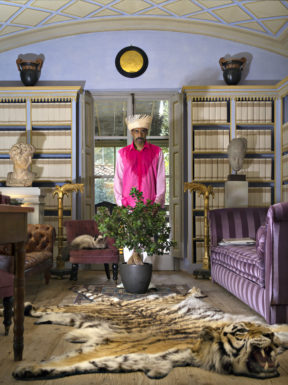
Nari WardSun Splashed, Listri Libreria, 2013 Chromogenic color print 83 7/8 x 63 inches (213 × 160 cm)Photographed by Lee Jaffe Courtesy the artist and Galleria Continua, San Gimignano, Beijing, Les Moulins, and Havana© 2017 Nari Ward
The final themed gallery, The Sun, highlights work that most directly speaks to Ward’s Jamaican roots and Caribbean stereotypes, a subject that weaves its way through much of Ward’s work. Canned Smiles (2013) -- a piece not included in this section and placed at the start of Sun Splashed -- purports to contain “black smiles” and “Jamaican smiles,” playing with the “Don’t Worry, Be Happy” stereotype of Jamaicans and performances of African American acquiescence, such as minstrel shows, that fulfill racist expectations. Canned Smiles riffs on Italian artist Piero Manzoni’s famous Artist’s Shit piece, and it was made in Rome where Ward lived temporarily as a recipient of the Rome Prize.⁴ A major component of The Sun section is a series of self-portraits also done in Rome where Ward is conspicuously not smiling. The photographs derive from performances where Ward entered a private home dressed in a straw hat and pink shirt, an outfit inspired by what his uncle wears on the album cover for his Happy Smilers band. Ward asked his host to group their domesticated tropical plants around him and water him along with the plants. In an interview, Ward describes his uncle as “a survivor just like the African American minstrel character—a nice, entertaining guy who was in some way disparaged but found a way to feed his family and survive.” With a stern, intense gaze, Ward conjures his uncle’s presence as he confronts prejudicial expectations.
In a conversation with fellow artist Tania Brugera at the ICA, Nari Ward said that one way he deals with our current tumultuous times is by looking at history. His statement had an interesting resonance with the fact that his retrospective was just upstairs in the museum's galleries, and a retrospective attempts to understand where an artist is by examining where they have been. Ward presents an interesting challenge for a retrospective. He is an artist who often understands the present through his own past, constantly re-exploring forms and concepts. Often working in international residency programs, Ward is as aware of where he has been as of where he currently is. The sculpture Land (2002-14) sits in the ICA lobby and consists of a “tree” made from the wheels of strollers and tricycles with an accompanying soundtrack of rolling wheels across pavement. An ode to his mobility and migratory experience, the title ironically suits Ward as an artist who never exactly “lands” in one place, but just as Land grows into a tree, his movement is generative.
¹ Diana Nawi, Nari Ward: Sun Splashed. (Munich, London, and New York: Prestel, 2015), 18 and 65.
² Wall label, Sun Splashed, the Institute of Contemporary Art/Boston, curated by Ruth Erickson and Jessica Hong. 26 April - 4 September 2017.
³ Mentioned in Ruth Erickson's Curator Tour on Nari Ward: Sun Splashed, 25 May 2017, at the Institute of Contemporary Art/Boston.
⁴ Nawi, 65.

